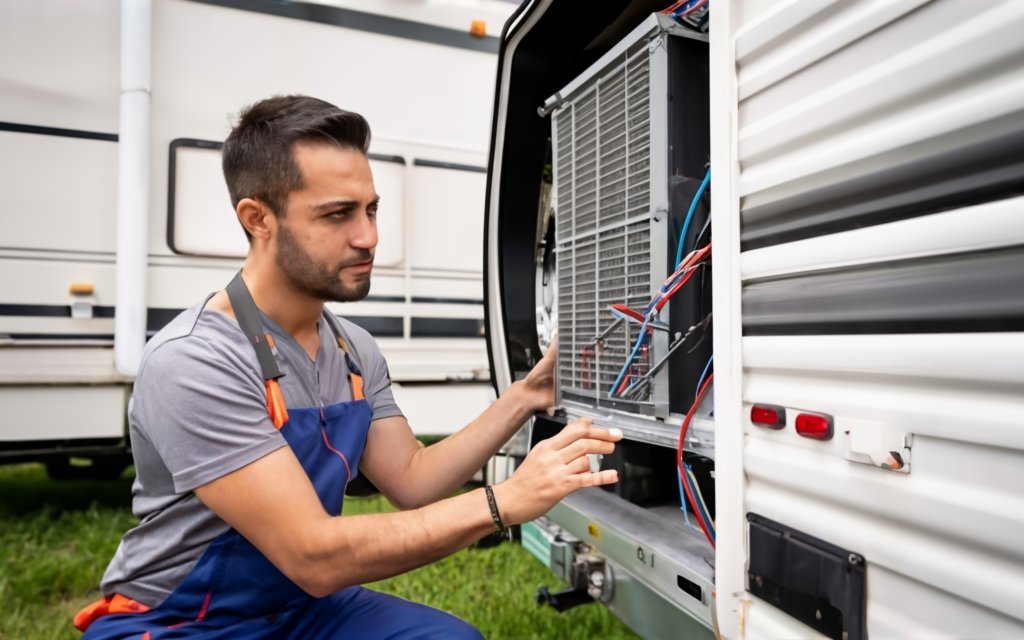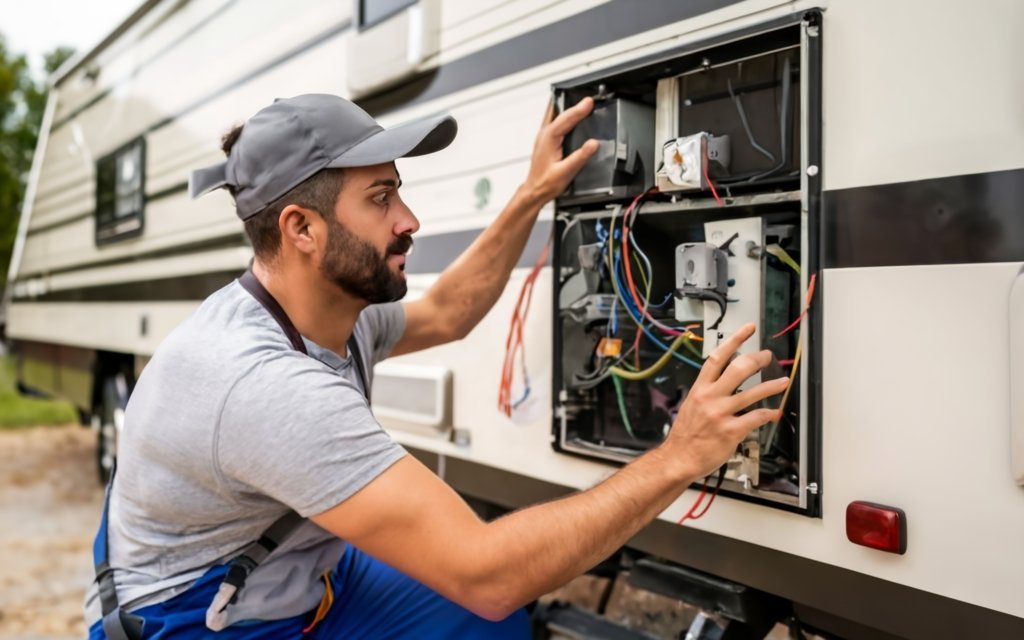There are a few reasons why your RV air conditioner might emit a musty odor. Here are the most common culprits:
Mold and mildew growth: The warm, humid environment inside an AC unit is ideal for mold and mildew to thrive. This is especially true if the unit hasn’t been used for a while or if it hasn’t been properly cleaned and maintained. Mold and mildew growth can be identified by a visible presence on the evaporator coil or drain pan, or by a strong, earthy smell.
Dirty evaporator coil: The coil is responsible for absorbing heat from the air, and it can become clogged with dust, dirt, and pollen over time. This buildup can also create a breeding ground for mold and mildew, leading to a musty odor.
Clogged drain pan: The drain pan collects condensation from the AC unit, and if it becomes clogged, water can back up and create a stagnant environment where mold and mildew can grow. You’ll know if the drain pan is clogged if you see water dripping from the unit or if there’s a puddle under it.
Dirty air filter: A dirty air filter can allow dust, dirt, and allergens to build up inside the AC unit, contributing to a musty smell.
Other possibilities: In some cases, the musty smell could be coming from a leak in the ductwork, a dead animal inside the unit, or even a problem with the electrical wiring.
Here are some steps you can take to get rid of the musty smell and prevent it from returning:
- Clean the evaporator coil and drain pan. You can use a commercial AC coil cleaner or a mixture of vinegar and water. Be sure to rinse the coil thoroughly afterward.
- Replace the air filter. Choose a high-quality air filter that is specifically designed for RV AC units.
- Check the drain pan for clogs and clean it out if necessary.
- Run the AC unit on fan mode only for a while after you’ve used it. This will help to dry out the unit and prevent mold and mildew growth.
- Inspect the ductwork for leaks and seal any gaps you find.
- Have the AC unit professionally serviced regularly. A qualified technician can check for any underlying problems and ensure the unit operates properly.
If you’re not comfortable cleaning the AC unit yourself, you can always hire a professional technician to do it for you. It’s important to address the musty smell as soon as possible, as mold and mildew can pose a health risk. After reading this article, you should read another article I wrote about >>>> What Happens When the RV Converter Goes Bad? to learn more about rvs.
Trapped in a Stinky Vortex: Why My RV Air Conditioner Betrayed Me (and How You Can Avoid the Same Fate)
Yo, fellow roadies, buckle up for a tale of woe – the tale of my air conditioner turning traitor and spewing a stench worthy of a dumpster fire. But fear not, for I’ve emerged victoriously from the olfactory battlefield, and I’m here to share the spoils of war: a battle plan against the dreaded musty RV AC.
Scene 1: Paradise Lost (or Rather, Smelly)
Picture this: the sun blaring down, the open road stretching endlessly, and… a pungent whiff of damp gym socks wafting from the supposed oasis of cool air. Yep, that was my first clue that something was seriously off with my trusty RV AC. I mean, sure, we’ve all encountered that funky “first-use” smell, but this was a whole new level of olfactory assault.
Diagnosis: The Usual Suspects:
So, armed with a flashlight and a nose firmly plugged with metaphorical clothespins, I went on a detective mission. Here’s what I found:
Exhibit A: The Moldy Menagerie:
Lurking within the cool, damp shadows of the evaporator coil were these fuzzy, greenish-gray patches – mold and mildew, the notorious odor-generating duo. Turns out, the warm, humid environment inside the AC unit is a five-star resort for these microscopic fiends.
Exhibit B: The Clogged Catastrophe:
The drain pan, responsible for draining away condensation, resembled a stagnant pond instead. Guess what happens when water hangs around too long? You guessed it – stagnation, breeding grounds for more mold, and, of course, that glorious musty aroma.

Exhibit C: The Neglected Ninja:
Hiding behind the grill, I found the culprit behind the dust-bunny stampede – a neglected air filter. Turns out, these guys are supposed to act as bouncers, keeping dirt and allergens out, but mine looked like a welcome mat for anything with legs (or spores).
The Takeaway:
This little investigation proved one thing – musty RV AC smells are rarely a mystery case. Usually, it’s a combination of these three amigos: mold, mildew, and neglect.
Stay tuned for Part 2, where I’ll unleash the weapons of mass deodorization and show you how to banish the stink and reclaim your cool haven on wheels!
In the meantime, here’s a handy table summarizing the culprits and their clues:
| Culprit | Clues |
|---|---|
| Mold & Mildew | Fuzzy greenish-gray patches on evaporator coil, earthy smell |
| Clogged Drain Pan | Fuzzy greenish-gray patches on the evaporator coil, earthy smell |
| Neglected Air Filter | Visible dust buildup, poor air quality, potential for mold growth |
Remember, prevention is key! Regular cleaning, filter replacements, and proper storage can keep your AC smelling fresh and your travels stink-free.
Stay tuned for Part 2, where the real fun (and cleaning) begins!
And hey, if you have any burning RV AC questions or smelly stories of your own, fire them away in the comments below! Let’s turn this stinky situation into a community knowledge bomb!
Part 3: Operation De-Stankification (Or, How I Fought Back Against the Musty Menace)
Alright, road warriors, it’s time to suit up for battle! In this chapter, I’ll reveal my arsenal of stink-fighting tactics to transform your AC from a biohazard into a breath of fresh air.
But first, a disclaimer: Know your limits. If you’re dealing with extensive mold growth, electrical issues, or serious mechanical problems, it’s time to call in the professionals.
For the rest of us DIY warriors, here’s the battle plan:
1. Target: The Moldy Menagerie
- Arm yourself: Grab a commercial AC coil cleaner or whip up a DIY solution of water and vinegar (50/50 mix).
- Attack plan:
- Turn off the AC power.
- Carefully access the evaporator coil (refer to your RV manual).
- Generously spray the cleaner onto the coil, letting it soak in.
- Pro tip: Use a soft brush to gently dislodge stubborn mold spores.
- Rinse thoroughly with clean water.
- Allow the coil to dry completely before turning the AC back on.
2. Mission: Unclog the Catastrophe.
- Equipment: Bucket, disposable gloves, vinegar or bleach solution, small brush, or pipe cleaner.
- Strategy:
- Locate the drain pan (usually underneath the AC unit).
- Remove any visible debris or algae.
- Pour a vinegar or bleach solution into the drain pan to dissolve the remaining buildup.
- Use a brush or pipe cleaner to clear any stubborn clogs in the drain line.
- Flush the drain pan with clean water.

3. Neutralize the Neglected Ninja
- Supplies: New air filter (specifically designed for RV AC units).
- Maneuver:
- Locate the air filter compartment.
- Remove the old filter (and dispose of it safely, especially if moldy).
- Insert the new filter, ensuring a proper fit.
- Pro tip: Set reminders for regular filter replacements (usually every 1-3 months).
Part 4: Fortifying the Fortress (Preventing Future Funky Fiascos).
Congratulations, you’ve vanquished the stench! But the battle isn’t over yet. Now’s the time to reinforce your defenses and prevent those musty marauders from returning. Here’s how:
1. Maintain a Dry Haven:
- Run the AC fan after use: This helps dry out the unit and prevent moisture buildup.
- Ventilate regularly: Crack open windows or roof vents to promote airflow and discourage mold growth.
- Store your RV with open vents: This allows for air circulation during periods of inactivity.
2. Schedule Regular Checkups:
- Inspect the AC unit: Visually check for mold, dirt, or clogs every few months.
- Change air filters religiously: Replace filters as recommended by the manufacturer (usually every 1-3 months).
- Professional tune-ups: Consider scheduling annual professional AC servicing for a thorough cleaning and maintenance check.
3. Preventative Measures:
- Cover the AC unit: Use a breathable cover to protect it from dust and debris during storage.
- Park in well-ventilated areas: Avoid shady, humid spots that trap moisture.
- Control humidity: Use a dehumidifier in your RV to reduce overall moisture levels.
4. Pro Tips for the Long Haul:
- Invest in a UV light: Install a UV light inside the AC unit to kill mold spores and bacteria.
- Consider a dehumidifier for the RV: A dedicated dehumidifier can help control overall moisture levels and prevent mold growth throughout the RV.
5. When to Call in the Cavalry:
- Extensive mold: If you encounter widespread mold growth, seek professional mold remediation services.
- Electrical or mechanical issues: Always consult a qualified RV technician for any electrical or mechanical problems.
Remember, prevention is infinitely more pleasant (and less smelly) than cure! By adopting these simple habits, you’ll keep your AC breathing fresh and your RV adventures stink-free.
Part 5: Final Stand (Reclaiming Your Cool Oasis).
With the AC now breathing fresh and the musty menace vanquished, it’s time to reclaim your cool haven on wheels! Kick back, relax, and enjoy the sweet, sweet scent of victory (and maybe a hint of pine-scented air freshener, just for good measure).
Remember, you’re now a seasoned veteran in the battle against RV AC odors. Share your newfound knowledge with fellow road warriors and help keep the RV community stink-free!
And if the musty menace dares to rea

Welcome to the enchanting world of Genah Reney, the esteemed Author-in-Residence at BAF TOURS International. Genah is not only a master storyteller but also a guiding force in weaving narratives that elevate the travel experience. Her literary prowess mirrors the essence of BAF TOURS, creating a seamless blend of captivating stories and the allure of global exploration.






